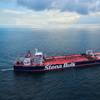OSBIT Power's MaXccess System Completes Offshore Trials
OSBIT Power (OP), Siemens Wind Power and Statoil announced that they have successfully completed offshore trials of OP’s offshore wind turbine access system, MaXccess. The trials were conducted with the backing of Siemens Wind Power and Statoil, at the Hywind Demo floating offshore wind turbine off the coast of Norway.
MaXccess was installed on the wind farm service vessel Bayard 3, operated by Fred Olsen Windcarrier, for the duration of the trials, conducted over the past month, from Statoil’s Hywind operations base at Skudeneshavn, Norway. The trials saw successful safe transfer of personnel taking place in conditions ranging from 1.2m up to 1.9m significant wave height (Hs). During the nine days of offshore operations, over 100 connections were made, with MaXccess being clamped to the turbine buffer tube for over 12 hours in total, during which time 36 personnel transfers were made.
Andrew Stormonth-Darling, Technical Project Manager: Service / Maritime Solutions, Siemens Wind Power, commented on MaXccess and implications for future operations.
“Over the past month, the systematic testing of the MaXccess system has resulted in a huge leap forward in improving transfers from the sort of crew transfer vessels we use widely across our projects,” said Stormonth-Darling. “The success of the trials is a testament to the engineering solution developed by OP, and will help lead the way to reduced operating costs and an improved safe working environment for technicians across the industry.”
Anders Wikborg, Marine Operations Manager, Offshore Wind Energy, Statoil comment that “it is vital that the industry supports innovations which have the potential to bring the cost of electricity down and increase safety of personnel working offshore. Developing new technology requires real world testing to validate performance. Through the trials we have conducted a thorough assessment of the MaXccess system and, in conjunction with DnV and Automasjon og Data, we have undertaken recordings of the wave conditions and motions of the vessel. Based on these, we can confirm that the system has achieved safe and reliable access in 1.9m significant wave height conditions.”













